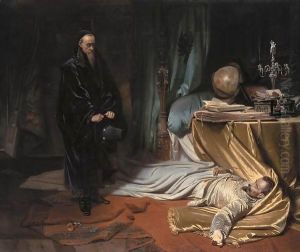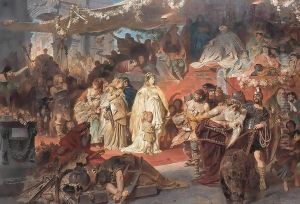Von Piloty Karl Theodor Paintings
Karl Theodor von Piloty was a German artist born on October 1, 1826, in Munich. He was a significant figure in the 19th-century German art world, especially known for his history paintings. His father, Ferdinand Piloty, was an engraver, and his brother, Ferdinand Piloty II, was a painter as well. This artistic environment influenced von Piloty's decision to pursue a career in art.
Von Piloty studied at the Academy of Fine Arts Munich and was influenced by the works of Peter von Cornelius and Julius Schnorr von Carolsfeld, who were proponents of the German Romantic and Nazarene movements. However, von Piloty would later develop his own style that diverged from these influences, characterized by a more realistic approach to historical subjects and a dramatic use of light and shadow.
In 1856, von Piloty became a professor at the Munich Academy and started to play a significant role in shaping the direction of German art. He became known for his large-scale history paintings, which were based on rigorous research to achieve historical accuracy. Some of his most famous works include 'Seni at the Dead Body of Wallenstein' (1855), depicting the moment after the assassination of the famous general Wallenstein during the Thirty Years' War, and 'Thusnelda at the Triumph of Germanicus' (1873), which presents a scene from ancient Rome.
Von Piloty was also a mentor to many artists who would go on to have successful careers, such as Hans Makart and Franz von Lenbach. Under his guidance, the Munich Academy became a leading center for art and attracted students from across Europe and the United States.
Karl Theodor von Piloty's influence extended beyond his own works; he played a pivotal role in the development of the history painting genre in Germany. His approach to historical accuracy combined with dramatic narrative set a standard for academic history painting during his time. Von Piloty died on July 21, 1886, in Munich. His legacy is preserved in his works that continue to be studied for their historical significance and artistic merit.

